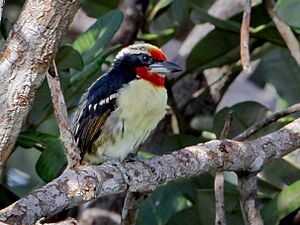Black-spotted barbet facts for kids
Quick facts for kids Black-spotted barbet |
|
|---|---|
 |
|
 |
|
| male and female | |
| Conservation status | |
| Scientific classification | |
| Genus: |
Capito
|
| Species: |
niger
|
 |
|
The black-spotted barbet (Capito niger) is a colorful bird. It belongs to the Capitonidae family. These birds are often called New World barbets. You can find them living in the forests of Brazil, the Guianas, and Venezuela.
Contents
About This Bird
For a long time, people thought the black-spotted barbet was a type of gilded barbet. It was seen as a subspecies, which means a slightly different group within the same species. However, scientists now consider it its own unique species.
The black-spotted barbet, the gilded barbet, and the brown-chested barbet are very similar. They are thought to form a "superspecies." This means they are closely related groups of species. The black-spotted barbet is currently considered "monotypic." This means it does not have any subspecies of its own.
What It Looks Like
The black-spotted barbet is about 16 to 19 cm (6.3 to 7.5 in) long. It weighs between 41 and 68 g (1.4 to 2.4 oz). These birds have many different colors. The exact brightness of their colors can change from one bird to another.
The adult male has a red forehead. Its crown and the back of its neck are yellowish. A black stripe runs from its eyes to the back of its neck. The back of its neck also has dark streaks. Its upper body is black. The feathers on its back have yellowish outlines. It also has yellowish stripes on its wings.
The male's throat is red. Its chest and belly are yellow. The sides of its body are yellow with a hint of olive green. These sides also have black streaks.
The adult female looks similar to the male. However, she has more markings. Her upper body has light spots on the black feathers. Her chest and belly have spots or streaks. Young birds look like adults but are not as brightly colored.
Where It Lives
The black-spotted barbet lives in eastern Venezuela. You can find it in the states of Bolívar and Delta Amacuro. It also lives in the three countries of the Guianas. These are Guyana, Suriname, and French Guiana. In Brazil, it lives in the states of Roraima, Pará, and Amapá. These areas are all north of the Amazon River.
This bird likes to live inside different kinds of forests. These include "terra firme" forests, which are on high ground. It also lives in "riparian" forests found near rivers. And it lives in "várzea" forests, which are flooded seasonally.
You can also see them at the edges of forests. They sometimes visit more open places like gardens and plantations. They live from sea level up to 200 m (660 ft) high in Venezuela. In the Guianas, they can be found as high as 800 m (2,600 ft).
How It Behaves
What It Eats
Scientists do not know much about what the black-spotted barbet eats. They also do not know much about how it finds food. However, they believe its diet and habits are similar to the gilded barbet.
How It Raises Young
The black-spotted barbet breeds from September to May. They might even breed until July. A pair of birds will dig a hole in a tree. This nest is usually 5 to 12 m (16 to 39 ft) above the ground. The female bird lays three or four eggs. Both the mother and father bird take turns sitting on the eggs to keep them warm.
What It Sounds Like
The black-spotted barbet's song is a low "wú-woot" sound. Sometimes it is just a single note. You can listen to it here: [1]. Its call is a rough, scratchy croak. You can hear its call here: [2].
Its Status
The IUCN (International Union for Conservation of Nature) has looked at the black-spotted barbet. They have decided it is a species of "Least Concern." This means it is not currently in danger of disappearing.
Scientists have not counted the exact number of these birds. However, the species is found across its range. It lives in several protected areas.


